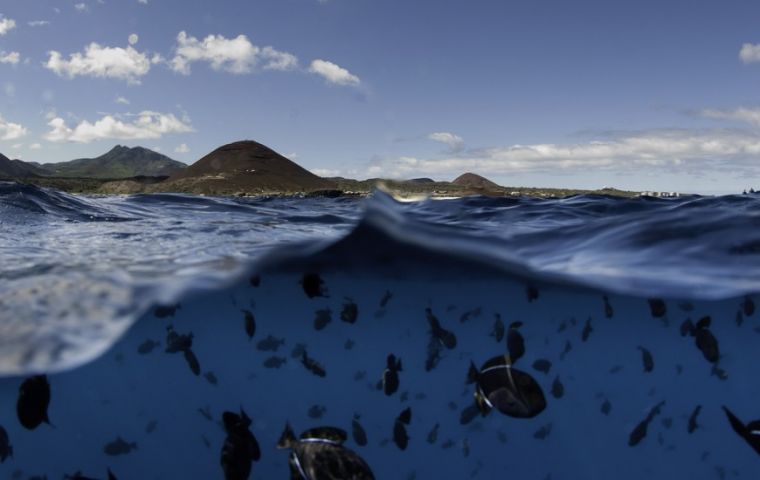MercoPress. South Atlantic News Agency
Ascension Island MPA; satellite data suggests conservation success likely
 Ascension Island's: home to one of the largest and healthiest green turtle rookeries in the Atlantic and a million seabirds breed and forage on its shores
Ascension Island's: home to one of the largest and healthiest green turtle rookeries in the Atlantic and a million seabirds breed and forage on its shores If United Nations goals are met, 10% of the world’s oceans could be marine reserves by 2020, but it has been suggested that many of these reserves will represent protection on paper but not in practice. However, new research trialling remote satellite monitoring of illegal fishing activity in the protected waters of Ascension Island from the Oxford Program of Sustainable Oceans suggests that here at least these “paper park” fears are not fully supported by evidence.
Ascension Island, a remote British Overseas Territory located in the South Atlantic Ocean, has a rich biodiversity. It is home to one of the largest and healthiest green turtle rookeries in the Atlantic, about a million seabirds breed and forage on its shores, its sensitive near-shore ecosystems and surrounding waters are home to 173 different fish species. Yet, some of these species have high commercial value. Fishing vessels catch primarily Big-Eyed Tuna, but also take Yellowfin Tuna, Albacore and Swordfish from Ascension’s waters. But under current management they can only do so if they have a licence and only in a controlled area to the north of the Island.
In collaboration with OceanMind, a not-for-profit organisation working to increase the sustainability of fishing globally, and the Ascension Island government researchers trialled the use of satellite monitoring technologies to support patrol vessel operations. They worked to target on-the-ground investigation on suspicious activity and understand the levels of legal and illegal fishing activity in the licensed fishing grounds to the north of the island and the fully-closed areas to the south, which could be formally declared a Marine Protection Area (MPA) in 2019. (*)
During the study, which covered January 2014 to March 2017, only three vessels were observed engaging in behaviours that might correspond to unlicensed fishing within the Ascension Island’s Exclusive Economic Zone (EEZ); an area defined by the 200 nautical mile limit, in which coastal states have control of marine resources. The majority of fishing vessel activity observed was outside of the Ascension Island EEZ. This indicates that a formal MPA in Ascension Island’s EEZ could be as successful in reducing fishing pressure.
Dr Gwilym Rowlands from the Oxford Martin Sustainable Oceans Program and Department of Zoology at the University of Oxford, lead author on a paper describing the study in the scientific journal Marine Policy, said: “our study demonstrates a willingness for vessel operators to move their activities outside of Ascension Island waters – this is positive news for those advocating marine protection in the region”.
However, researchers also note that vigilance and continued satellite monitoring combined with patrol vessels will need to remain to ensure this. They also noted that the most accessible form of satellite monitoring for ocean-going vessels, the satellite Automatic Identification System (S-AIS), is not sufficient on its own. “Such tracking data does not provide a complete picture of vessel compliance. A large number of fishing vessels either do not have the necessary AIS transponders installed, or do not transmit their location continuously,” said Bradley Soule, Chief Fisheries Analyst at OceanMind.
To locate these ‘dark’ vessels another type of satellite data was also used to monitor and manage compliance. This Synthetic Aperture Radar uses radio waves to image large metal objects against the ocean. It works even through cloud, and can be used to look for ships that would be otherwise undetectable. Both types of satellite data would be needed to maintain the awareness levels achieved during the trial.
Dr Rowlands also warns, “Conservation management measures are most likely to be successful if economically self-sustainingand despite the clear benefits and economies of scale delivered by satellite monitoring, it remains expensive.”
Small island states, like Ascension Island, are often at the centre of marine protection activities yet have limited internal revenue streams. Although it was expected that the revenue generated from the licensed fishery would support monitoring and management of the MPA, current licence uptake suggest the offsetting revenue will be minimal.
“The long-term conservation benefit of a large MPA around Ascension Island will only be accrued through ongoing financial and institutional commitments on the part of the UK government, which must be backed by public support”, said Dr Rowlands.
The research paper ”Satellite surveillance of fishing vessel activity in the Ascension Island Exclusive Economic Zone and Marine Protected Area” was published in the journal Marine Policy and will feed into the government consultation process for formal designation of an MPA within the Ascension Island EEZ.
(*) The proposed MPA around Ascension Island is being considered as part of the UK Blue Belt Programme, an intent to protect over 4 million square kilometres of ocean around the UK overseas territories. The UK government has committed to closing at least 221,761.5 km2, an area similar to that of the UK, to commercial fishing. Options up to 443,523 km2, encompassing the full extent of the Ascension Island EEZ, are however under consideration.




Top Comments
Disclaimer & comment rulesCommenting for this story is now closed.
If you have a Facebook account, become a fan and comment on our Facebook Page!